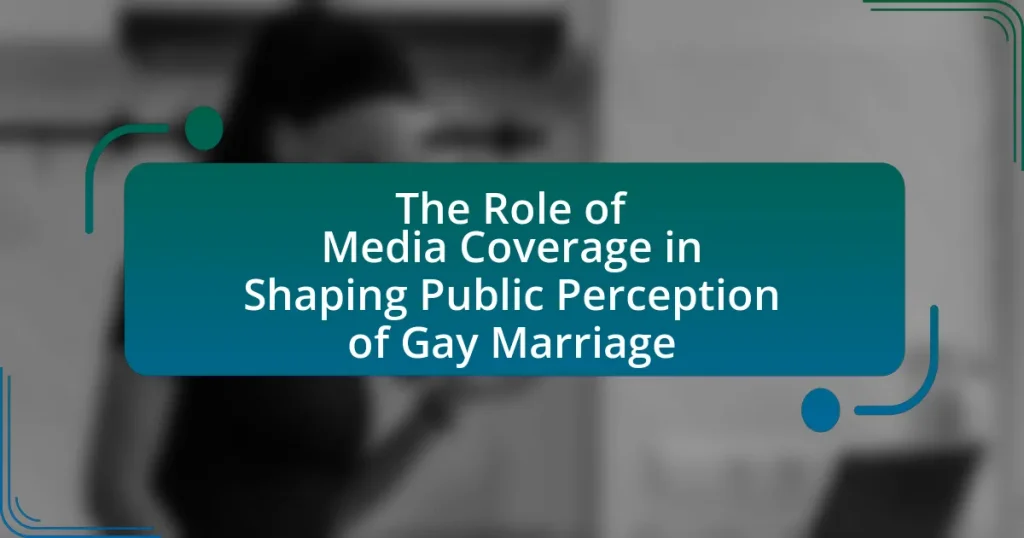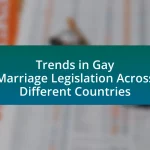The article examines the significant role of media coverage in shaping public perception of gay marriage. It highlights how positive media representation influences societal attitudes, leading to increased acceptance and support for LGBTQ+ rights. Key findings indicate that various media types, including television, social media, and print, contribute to normalizing same-sex relationships and framing gay marriage as a civil rights issue. The article also discusses the evolution of media narratives over time, the impact of landmark legal decisions, and best practices for responsible media coverage to foster understanding and empathy towards gay marriage.
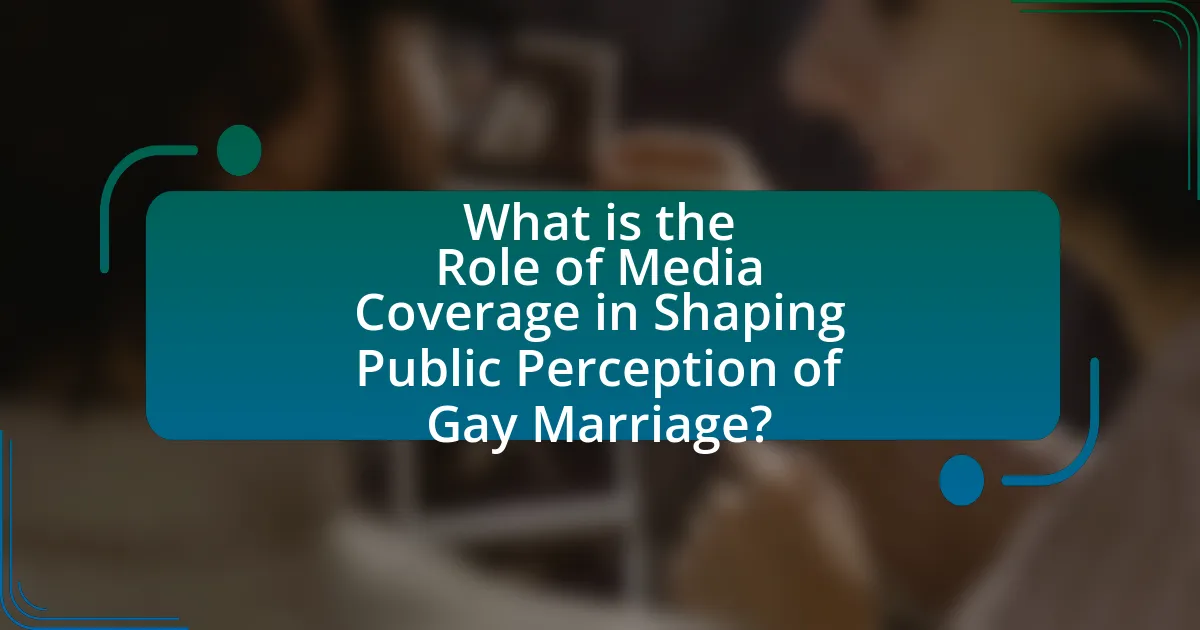
What is the Role of Media Coverage in Shaping Public Perception of Gay Marriage?
Media coverage plays a crucial role in shaping public perception of gay marriage by influencing societal attitudes and beliefs through the framing of narratives. Research indicates that positive media representation can lead to increased acceptance and support for gay marriage; for instance, a study published in the Journal of Communication found that exposure to supportive media narratives significantly correlated with more favorable attitudes towards LGBTQ+ rights. Furthermore, the portrayal of personal stories and experiences in media can humanize the issue, making it more relatable and fostering empathy among audiences. This effect is evident in the shift in public opinion in the United States, where support for gay marriage rose from 27% in 1996 to over 70% by 2021, coinciding with increased media visibility and advocacy.
How does media coverage influence societal attitudes towards gay marriage?
Media coverage significantly influences societal attitudes towards gay marriage by shaping public discourse and normalizing LGBTQ+ relationships. Research indicates that positive media representation, such as inclusive narratives and visibility of same-sex couples, correlates with increased public support for gay marriage. For instance, a study published in the journal “Public Opinion Quarterly” found that exposure to supportive media coverage led to a 10% increase in acceptance of gay marriage among viewers. Furthermore, media framing of gay marriage as a civil rights issue has been shown to shift perceptions, making it more relatable and acceptable to broader audiences. This demonstrates that the way media presents information can directly impact societal beliefs and attitudes regarding gay marriage.
What types of media are most impactful in shaping these perceptions?
The types of media most impactful in shaping perceptions of gay marriage include television, social media, and print media. Television has historically played a significant role by featuring narratives and characters that normalize same-sex relationships, influencing public attitudes; for example, shows like “Will & Grace” contributed to increased acceptance. Social media platforms allow for the rapid dissemination of information and personal stories, fostering community support and activism, as evidenced by campaigns like the Human Rights Campaign’s #LoveWins. Print media, including newspapers and magazines, provide in-depth analysis and coverage of legal and social developments regarding gay marriage, shaping public discourse and opinion. These media types collectively contribute to evolving societal perceptions by providing visibility, representation, and dialogue around gay marriage issues.
How do different media narratives affect public opinion on gay marriage?
Different media narratives significantly influence public opinion on gay marriage by framing the issue in ways that resonate with audiences. For instance, positive portrayals of same-sex couples in television shows and news stories can foster empathy and acceptance, leading to increased support for gay marriage. Research by the Pew Research Center indicates that exposure to supportive media narratives correlates with higher approval ratings for same-sex marriage, with support rising from 27% in 1996 to 70% in 2021 among Americans, largely attributed to changing media representations. Conversely, negative narratives can reinforce prejudices and opposition, demonstrating that the framing of gay marriage in media directly impacts societal attitudes and acceptance levels.
Why is media representation important in the context of gay marriage?
Media representation is important in the context of gay marriage because it shapes societal attitudes and influences public opinion. Positive portrayals of gay marriage in media can lead to increased acceptance and normalization of LGBTQ+ relationships, as evidenced by studies showing that exposure to inclusive media content correlates with more favorable views on same-sex marriage. For instance, a 2015 study published in the journal “Communication Research” found that individuals who consumed media featuring LGBTQ+ characters were more likely to support marriage equality. Thus, media representation plays a crucial role in fostering understanding and reducing stigma surrounding gay marriage.
What role does visibility play in changing perceptions of gay marriage?
Visibility plays a crucial role in changing perceptions of gay marriage by increasing awareness and normalizing same-sex relationships within society. When gay couples are represented in media, such as television shows, films, and news stories, it fosters understanding and acceptance among viewers. Research indicates that exposure to positive portrayals of LGBTQ+ individuals can lead to more favorable attitudes toward gay marriage; for instance, a study published in the journal “Public Opinion Quarterly” found that individuals who consumed media featuring gay characters were more likely to support marriage equality. This visibility not only challenges stereotypes but also humanizes the experiences of gay individuals, making it easier for the public to empathize with their struggles for rights and recognition.
How do stereotypes in media coverage affect public understanding of gay marriage?
Stereotypes in media coverage significantly distort public understanding of gay marriage by perpetuating narrow and often negative representations of LGBTQ+ individuals. These stereotypes can lead to misconceptions about the motivations and experiences of same-sex couples, influencing societal attitudes and acceptance. For instance, studies have shown that media portrayals often emphasize conflict or sensationalism rather than the everyday realities of gay relationships, which can reinforce biases and hinder empathy. Research by the Williams Institute indicates that positive media representation correlates with increased public support for gay marriage, highlighting the critical role that accurate and diverse portrayals play in shaping informed opinions.
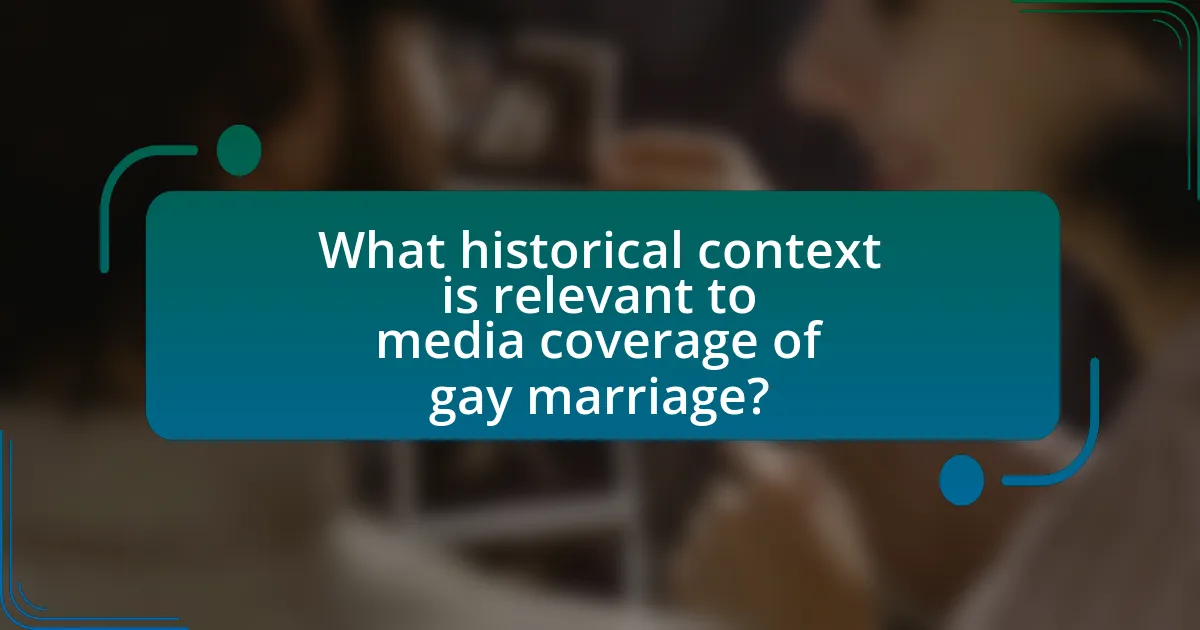
What historical context is relevant to media coverage of gay marriage?
Media coverage of gay marriage is significantly influenced by the historical context of LGBTQ+ rights movements, particularly the Stonewall Riots of 1969, which marked a pivotal moment in the fight for gay rights in the United States. This event catalyzed activism and increased visibility for LGBTQ+ issues, leading to a gradual shift in public perception. Over the decades, media representation evolved from negative stereotypes to more nuanced portrayals, especially during key milestones such as the legalization of same-sex marriage in various states and the landmark Supreme Court decision in Obergefell v. Hodges in 2015, which legalized same-sex marriage nationwide. These developments were extensively covered by media outlets, reflecting and shaping societal attitudes towards gay marriage, as evidenced by increased public support in polls following positive media narratives.
How has media coverage evolved over time regarding gay marriage?
Media coverage of gay marriage has evolved from largely negative and stigmatizing portrayals to more supportive and inclusive representations. In the early 1990s, media often framed gay marriage as a controversial and fringe issue, with limited coverage focused on opposition and legal battles, such as the 1996 Defense of Marriage Act. By the early 2000s, coverage began to shift, reflecting growing public support and featuring personal stories of same-sex couples, particularly during landmark events like the Massachusetts legalization in 2004.
As public opinion continued to change, culminating in the 2015 Supreme Court decision in Obergefell v. Hodges, media coverage increasingly highlighted the human rights aspect of gay marriage, showcasing it as a matter of equality. Studies, such as those conducted by the Pew Research Center, indicate that media representation has played a significant role in shaping public perception, with a notable increase in positive framing and visibility of LGBTQ+ voices in mainstream outlets. This evolution reflects broader societal changes and has contributed to the normalization of gay marriage in public discourse.
What significant events have influenced media narratives on gay marriage?
Significant events that have influenced media narratives on gay marriage include the 2003 U.S. Supreme Court decision in Lawrence v. Texas, which invalidated sodomy laws and set a precedent for LGBTQ rights, and the 2015 Supreme Court ruling in Obergefell v. Hodges, which legalized same-sex marriage nationwide. These rulings prompted extensive media coverage that framed gay marriage as a civil rights issue, shifting public perception. Additionally, events such as the 2004 Massachusetts legalization of same-sex marriage and the rise of LGBTQ advocacy groups have contributed to changing narratives, as media outlets began to highlight personal stories and the societal impacts of marriage equality, further influencing public opinion and acceptance.
How did early media portrayals differ from contemporary representations?
Early media portrayals of gay marriage often depicted it in a negative light, focusing on stereotypes and sensationalism, while contemporary representations tend to be more inclusive and nuanced, reflecting a broader acceptance of LGBTQ+ rights. In the 1980s and 1990s, media coverage frequently emphasized conflict and controversy, often framing gay marriage as a threat to traditional values, as seen in news segments that highlighted opposition from religious groups. In contrast, recent media portrayals showcase diverse narratives, including personal stories of same-sex couples, which humanize the issue and promote understanding, as evidenced by the increased visibility of LGBTQ+ characters in mainstream television and film. This shift in representation has contributed to changing public perceptions, with polls indicating growing support for gay marriage over the past two decades.
What impact did landmark legal decisions have on media coverage of gay marriage?
Landmark legal decisions significantly influenced media coverage of gay marriage by shifting public discourse and framing the issue as a civil rights matter. For instance, the 2015 Supreme Court ruling in Obergefell v. Hodges, which legalized same-sex marriage nationwide, prompted extensive media coverage that highlighted personal stories and the legal implications of the decision. This coverage contributed to a broader acceptance of gay marriage in society, as media outlets began to portray same-sex couples in a more positive light, emphasizing equality and love rather than stigma. Consequently, the framing of gay marriage in the media evolved, reflecting changing societal attitudes and reinforcing the legitimacy of same-sex relationships.
How did the media respond to the legalization of gay marriage in various regions?
The media generally responded positively to the legalization of gay marriage in various regions, often framing it as a significant step toward equality and civil rights. Coverage included celebratory articles, opinion pieces advocating for LGBTQ+ rights, and extensive reporting on the social and legal implications of the rulings. For instance, following the U.S. Supreme Court’s decision in Obergefell v. Hodges in 2015, major news outlets like The New York Times and CNN highlighted the historic nature of the ruling, emphasizing its impact on American society and the lives of same-sex couples. Additionally, international media also reported on similar legalizations, such as in Ireland and Australia, showcasing public support and the cultural shifts accompanying these changes. This positive media portrayal contributed to a broader acceptance of gay marriage, influencing public perception and policy discussions in various regions.
What role did media play in the public discourse surrounding these legal changes?
Media played a crucial role in shaping public discourse surrounding legal changes related to gay marriage by influencing public opinion and framing the narrative. Through extensive coverage, media outlets highlighted personal stories, legal arguments, and societal implications, which helped to humanize the issue and foster empathy among audiences. For instance, studies have shown that positive media portrayals of same-sex couples significantly increased public support for marriage equality, as evidenced by a 2015 Pew Research Center survey indicating that support for gay marriage rose from 27% in 1996 to 55% in 2015, largely attributed to changing media narratives. Additionally, media platforms served as forums for debate, allowing diverse viewpoints to be expressed, which further engaged the public and encouraged discussions around the legal changes.
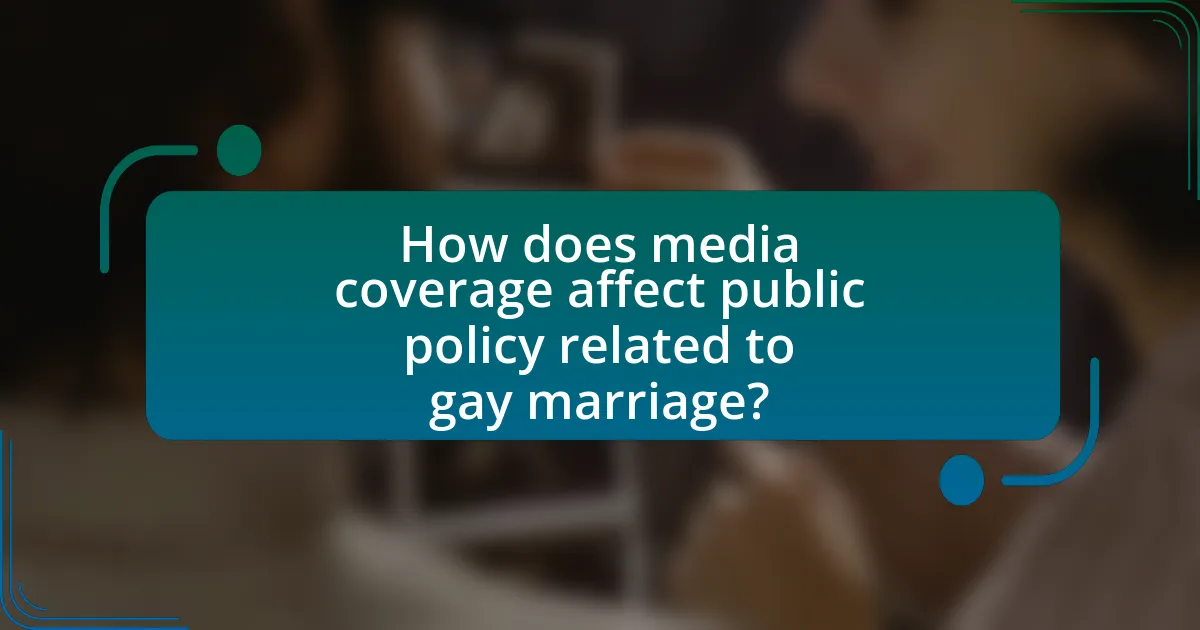
How does media coverage affect public policy related to gay marriage?
Media coverage significantly influences public policy related to gay marriage by shaping societal attitudes and increasing visibility of LGBTQ+ issues. For instance, extensive media representation of gay marriage debates and personal stories has contributed to a shift in public opinion, as evidenced by a 2019 Gallup poll showing that 70% of Americans supported same-sex marriage, up from 27% in 1996. This change in public sentiment often pressures lawmakers to align policies with the evolving views of their constituents, leading to legislative advancements such as the legalization of same-sex marriage in various states and the Supreme Court’s decision in Obergefell v. Hodges in 2015, which recognized same-sex marriage nationwide. Thus, media coverage acts as a catalyst for policy change by informing and influencing public perception.
What influence does media coverage have on lawmakers’ decisions regarding gay marriage?
Media coverage significantly influences lawmakers’ decisions regarding gay marriage by shaping public opinion and highlighting societal attitudes. When media outlets extensively cover gay marriage, they often frame it in a positive light, which can lead to increased public support. For instance, a study by the Pew Research Center in 2015 indicated that media representation of LGBTQ+ issues contributed to a shift in public opinion, with support for same-sex marriage rising from 27% in 1996 to 55% in 2015. This shift in public sentiment pressures lawmakers to align their policies with the evolving views of their constituents, as elected officials often seek to reflect the values and preferences of the electorate to maintain their positions. Consequently, lawmakers may be more inclined to support legislation that legalizes or protects gay marriage when they perceive strong public backing, as evidenced by the rapid legalization of same-sex marriage in various states following extensive media coverage and public discourse on the topic.
How do public perceptions shaped by media affect legislative outcomes?
Public perceptions shaped by media significantly influence legislative outcomes by creating a narrative that lawmakers often respond to. For instance, media coverage of gay marriage has shifted public opinion over time, leading to increased support for legalization. According to a 2015 study published in the American Journal of Political Science, states with more positive media portrayals of same-sex marriage saw a higher likelihood of legislative approval for marriage equality laws. This correlation demonstrates that when media frames an issue positively, it can mobilize public support, prompting legislators to align their policies with the prevailing public sentiment.
What examples exist of media influencing policy changes related to gay marriage?
Media has significantly influenced policy changes related to gay marriage through various examples. One notable instance is the coverage of the 2013 Supreme Court case United States v. Windsor, where media narratives highlighted personal stories of same-sex couples, contributing to public support for marriage equality. This coverage coincided with a shift in public opinion, as a Gallup poll indicated that support for same-sex marriage rose from 40% in 2009 to 55% in 2013, reflecting the impact of media on societal attitudes. Additionally, the portrayal of gay marriage in popular television shows, such as “Modern Family,” helped normalize same-sex relationships, further influencing public perception and, ultimately, policy changes, as seen in the legalization of gay marriage in several states following increased media visibility.
How can media coverage promote positive change in public perception of gay marriage?
Media coverage can promote positive change in public perception of gay marriage by highlighting personal stories and experiences of LGBTQ+ individuals, which fosters empathy and understanding. For instance, studies have shown that when media outlets feature narratives of same-sex couples, it humanizes the issue and challenges stereotypes, leading to increased support for marriage equality. A 2015 study published in the journal “Communication Research” found that exposure to positive media portrayals of gay relationships significantly improved attitudes toward gay marriage among viewers. By consistently presenting inclusive and affirming content, media can shift societal norms and encourage acceptance of gay marriage.
What strategies can media outlets use to foster acceptance of gay marriage?
Media outlets can foster acceptance of gay marriage by promoting inclusive narratives, showcasing personal stories, and providing factual information about LGBTQ+ rights. Inclusive narratives help normalize gay marriage by framing it as a part of everyday life, while personal stories humanize the issue, allowing audiences to connect emotionally with LGBTQ+ individuals. For instance, coverage that highlights the experiences of same-sex couples can shift public perception by illustrating their love and commitment. Additionally, presenting factual information about the legal and social benefits of gay marriage, such as studies showing that legal recognition improves mental health outcomes for LGBTQ+ individuals, reinforces the argument for acceptance. Research from the Williams Institute indicates that states with marriage equality see a decrease in mental health issues among LGBTQ+ populations, further supporting the need for positive media representation.
How can storytelling in media create empathy and understanding for gay marriage?
Storytelling in media can create empathy and understanding for gay marriage by humanizing the experiences of LGBTQ+ individuals through relatable narratives. These narratives often depict the challenges, joys, and complexities of same-sex relationships, allowing audiences to connect emotionally with the characters. For instance, studies have shown that exposure to positive portrayals of gay couples in films and television can reduce prejudice and increase acceptance among viewers. A notable example is the television series “Modern Family,” which features a loving gay couple, leading to a significant shift in public attitudes towards gay marriage, as evidenced by a 2015 study published in the journal “Communication Research.” This study found that viewers who watched the show reported more favorable views on LGBTQ+ rights, demonstrating the power of storytelling in fostering empathy and understanding.
What are best practices for responsible media coverage of gay marriage?
Best practices for responsible media coverage of gay marriage include using inclusive language, ensuring accurate representation of LGBTQ+ voices, and providing context about the legal and social implications of marriage equality. Inclusive language fosters respect and understanding, while accurate representation ensures that diverse perspectives within the LGBTQ+ community are heard, as highlighted by studies showing that representation can influence public opinion positively. Additionally, providing context helps audiences understand the historical struggles and ongoing challenges faced by the LGBTQ+ community, reinforcing the importance of marriage equality in the broader fight for civil rights.
How can journalists ensure accurate representation of gay marriage issues?
Journalists can ensure accurate representation of gay marriage issues by employing thorough research, inclusive language, and diverse perspectives. Thorough research involves verifying facts and statistics related to gay marriage, such as the legal status across different states and countries, which can be supported by data from organizations like the Human Rights Campaign. Inclusive language helps avoid stereotypes and biases, fostering a respectful portrayal of LGBTQ+ individuals. Additionally, incorporating diverse perspectives, including voices from various communities within the LGBTQ+ spectrum, ensures a more comprehensive understanding of the issues at hand. This approach not only enhances the credibility of the reporting but also contributes to a more informed public discourse on gay marriage.
What ethical considerations should media outlets keep in mind when covering gay marriage?
Media outlets should prioritize accuracy, fairness, and respect for the dignity of individuals when covering gay marriage. Ensuring that reporting reflects the diverse perspectives within the LGBTQ+ community is essential, as it fosters a more inclusive narrative. Additionally, media should avoid sensationalism and stereotypes that can perpetuate stigma, as studies have shown that biased representations can influence public attitudes negatively. For instance, the American Psychological Association emphasizes the importance of responsible media portrayals in shaping societal acceptance and understanding of LGBTQ+ issues. By adhering to these ethical considerations, media can contribute positively to the public discourse surrounding gay marriage.
